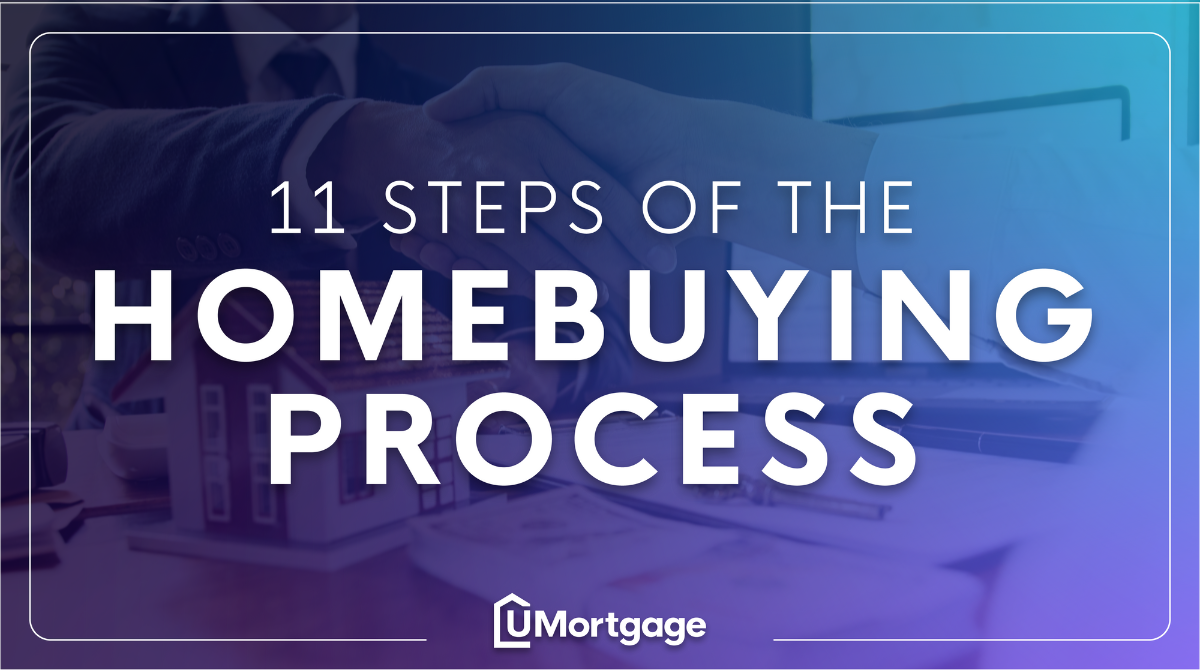Step-By-Step Guide to Buying a Home
Published: December 14, 2023

Step-By-Step Guide to Buying a Home
Buying a home can seem a lot more daunting than it is from the outside looking in. It’s one of the biggest financial commitments you can make, but with proper preparation and an understanding of the process, you can make sure your homebuying journey is a breeze.
Below, we’ve broken down the homebuying process into 11 steps. Some steps are more fun than others, but all will contribute to a life-changing purchase.
Step 1: Assess Your Readiness
Becoming a homeowner is a life-changing commitment that has benefits that will last a lifetime. But before you decide to start the homebuying process, you must assess your readiness.
Financial preparation is important, but being mentally and emotionally ready is almost just as important. When you buy a home, you should expect to live there for at least three years to make the purchase worthwhile.
When you decide to start the process, consider a few of your goals for the next couple of years. Do you plan on staying in the same job? Are you buying with a partner? Do you think you might want to start a family in the near future? Identifying these big-picture goals can help you realize if you’re ready to buy a home.
Step 2: Get a Snapshot of Your Financial Situation
Buying a home is likely the biggest financial decision you can make. Before you start the process, you’ll want to make sure that you have your finances in order and a plan in place.
You’ll want to check your credit score. Healthy credit is one of the cornerstones to getting a favorable rate when you apply for your mortgage. If you need to improve your credit score, check out our blog on the steps to take to repair your credit.
If you want to a good idea of what you can afford, use our affordability calculator! This uses your credit score, annual income, monthly debts, down payment, and an estimate of your interest rate based on location, credit, down payment, and loan term to provide you with an approximate maximum home price and monthly payment.
Step 3: Budget For a Down Payment & the Other Homebuying Fees
Your down payment and closing costs are perhaps the largest lump sum that you’ll spend when you buy a home. The down payment is your one-time payment towards the purchase of your home. Many individuals believe that a 20% down payment is required, but in some cases, you can get a conventional loan with as little as 3% down!
There are caveats to a lower down payment, though. Although you are paying less money upfront, you’ll most likely have to pay mortgage insurance which can increase your monthly payment.
For many first-time homebuyers, there are down payment assistance programs that can offer financial health through the form of a forgivable grant. DPA programs vary from state to state and even city to city, so speak with an expert to learn what’s available in your area!
If you have friends or family members who can afford to help, you can also use gift money to increase your down payment. Rules regarding gift money vary by loan program.
You’ll also need to save some money to cover closing costs, which are the fees you pay to get your loan. Typically, closing costs are around 3-6% of the home’s value. Your loan type, lender, and location will determine how much your closing costs will be.
Step 4: Create a List of Wants and Non-Negotiables
Do you want a fixer-upper or something that’s move-in ready? Would you rather live in a walkable area or something that’s got more land? And if you’re considering starting a family or already have one, which areas have better school districts?
These are the questions you’ll want to have nailed-down answers to before you hit the market. Knowing your wants and needs from the jump will be hugely beneficial when it becomes time to start searching for homes.
Step 5: Connect With an LO and Get Pre-Approved
You wouldn’t go shopping without your wallet. Well, shopping for a home without a pre-approval letter is the same thing. Once you’ve assessed your readiness, budgeted, and analyzed what you want in your home, connecting with a loan originator to get a pre-approval is the first official step of the homebuying process.
A pre-approval letter will give you a solid estimate of your homebuying budget. Getting pre-approved is quick and can be done over the phone. A loan originator will pull your credit score and ask you basic questions regarding your income and other debts to provide you with a number that you can use as a point of reference when narrowing down your home search by list price.
Not only does a pre-approval give you a solid budget to work off, but it also shows sellers and real estate agents that you’re a serious buyer and can access financing. It also will make the actual loan application process go by quickly since you already have most of these financial documents handy, easing stress down the line.
Step 6: Find a Real Estate Agent & Start Shopping
It’s not necessary to hire a real estate agent, but it’s hugely beneficial and highly recommended. An experienced real estate agent will know the ins and outs of your local market, help you find homes on the market and ones hitting the market in the future, write your offer letter, and assist in negotiations.
There are a few different ways that you can find a good real estate agent. Most people will ask friends or family members if they recommend the agent they’ve worked with, and if you’re already working with a loan originator, they likely have some partners that they work with and trust as well.
With a pre-approval letter in hand and a trustworthy real estate agent by your side, the fun begins; it’s time to hit the housing market! Your real estate agent will help send you listings and even some homes that haven’t hit the market yet.
When you’re looking at homes in person and online, this is when your list of wants & non-negotiables comes in handy. Try to keep note of the things you like and dislike about each home so you can reevaluate when comparing your options.
Step 7: Make an Offer
Now that you’ve found the home that ticks all the boxes and is within your budget, it’s time to make an offer! This is where your real estate agent will really come in handy. They’ll be able to pull comparable sales information and insight from the selling agent to gauge how much competition you might face for the home and whether the seller is motivated to sell quickly. From here, they’ll help you write the offer and provide their insight to make sure you get a good deal.
If your offer is rejected, you can work with your agent to make a counteroffer, or you can continue your home search. Negotiations can take some time, and this is where you should lean on your agent’s expertise.
Once you have an offer accepted, there are just a few steps to go!
Step 8: Apply For Your Mortgage
Now that you’ve had your offer accepted, you know how much you’ll need to lend in order to buy your home. Working with your loan originator, you’ll go through your options to pick the mortgage that works best for you.
When you work with experienced loan originators like myself, we can shop rates for you from a portfolio of different lenders to find the rate and term that works best for the buyer’s individual circumstances.
The process for getting your mortgage involves quite a few financial documents that you’ll have to gather. Here’s what you should prepare when you’re ready to apply:
- Tax documents for the last two years
- Bank statements for the last couple of months
- Pay stubs for the last two months
- Proof of any other income or funds (like gift money)
- Driver’s license and social security number
There’s plenty that goes on behind the scenes when you take your loan from application to clear-to-close, but when you’re buying with UMortgage, you can rest easy knowing that your loan is being handled by our best-in-class Operations team. Once you’re approved, your loan will go into underwriting. Here, your lender makes the final decision and approves your loan once everything is reviewed.
Step 9: Get a Homeowners Insurance Policy & Schedule an Appraisal
Before you close on your home, you’re required by lenders to secure a homeowners insurance policy and have your home appraised. These are two conditions that lenders require you to meet before closing on your home.
You’ll want your homeowners insurance policy to have enough coverage to fully replace the home’s value and to become effective on your closing date.
Your appraisal is required to make sure the lender isn’t lending you more money than the home is worth. Typically, the lender will order the appraisal for you and will bill you directly for the cost.
Step 10: Have the Home Inspected
Although this is an optional step, it’s highly recommended to ensure that the home you’re about to commit to is in good condition. When you’re paying upwards of tens of thousands of dollars for your down payment and closing costs, the last thing you want is to find out that you’ve got a faulty water heater or HVAC unit to burn a hole in your pocket once you’ve moved in.
Home inspections typically cost anywhere from $200 to $700. If your inspection finds any major issues, you typically have a contingency that allows you to back out of the agreement before you close. If any relatively minor issues are discovered, you can negotiate with the seller to have the repairs made or have them pay you to fix them after you’ve moved in.
Although it’s optional and could seem like a good place to cut costs before you start signing checks on the closing table, getting a thorough home inspection is a relatively small cost to ensure you’re not saddled with any large and unexpected repair costs once you’re settled in your new home.
Step 11: Close On Your Home & Move In!
The 11th and final step of your homebuying process is the most exciting. All the hard work put in to budget, save, house hunt, and provide all the necessary documentation to get your mortgage culminates in you putting pen to paper and making the home yours.
At least three business days before your closing date, your lender will provide you with your closing disclosure. This document clearly outlines all the costs that go into finalizing your mortgage and the costs that are due from you at closing.
On or before your closing date, you’ll do a final walkthrough of the home with your real estate agent. During your walkthrough, you should check to make sure that any potential repairs negotiated after your inspection have been made and that all agreed items, such as appliances, are accounted for in the home.
It might seem like a long and arduous process, but buying a home is one of the most rewarding investments you can make. Working with experienced professionals will go a long way towards making it as stress-free and smooth as possible. If you’re ready to get started, contact your UMortgage loan originator for an initial conversation!
